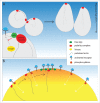Yeast chemotropism: A paradigm shift in chemical gradient sensing
- PMID: 28702274
- PMCID: PMC5501219
- DOI: 10.1080/21592799.2017.1314237
Yeast chemotropism: A paradigm shift in chemical gradient sensing
Abstract
The ability of cells to direct their movement and growth in response to shallow chemical gradients is essential in the life cycles of all eukaryotic organisms. The signaling mechanisms underlying directional sensing in chemotactic cells have been well studied; however, relatively little is known about how chemotropic cells interpret chemical gradients. Recent studies of chemotropism in budding and fission yeast have revealed 2 quite different mechanisms-biased wandering of the polarity complex, and differential internalization of the receptor and G protein. Each of these mechanisms has been proposed to play a key role in decoding mating pheromone gradients. Here we explore how they may work together as 2 essential components of one gradient sensing machine.
Keywords: GPCR; chemical gradient sensing; chemotropism; heterotrimeric G protein; pheromone response; yeast mating.
Figures

References
-
- Morita MT. Directional gravity sensing in gravitropism. Annu Rev Plant Biol 2010; 61:705-20; PMID:19152486; http://dx.doi.org/10.1146/annurev.arplant.043008.092042 - DOI - PubMed
-
- Jékely G. Evolution of phototaxis. Philos Trans R Soc Lond B Biol Sci 2009; 364(1531):2795-808; PMID:19720645; http://dx.doi.org/10.1098/rstb.2009.0072 - DOI - PMC - PubMed
-
- Cortese B, Ilaria A, Palamà E, D ’amone S, Gigli G. Influence of electrotaxis on cell behaviour. Integr Biol 2014; 6(6):817-30; http://dx.doi.org/10.1039/C4IB00142G - DOI - PubMed
-
- Cai H, Devreotes PN. Moving in the right direction: How eukaryotic cells migrate along chemical gradients. Semin Cell Dev Biol 2011; 22(8):834-41; PMID:21821139; http://dx.doi.org/10.1016/j.semcdb.2011.07.020 - DOI - PMC - PubMed
-
- Arkowitz RA. Chemical gradients and chemotropism in yeast. Cold Spring Harb Perspect Biol 2009; 1(2):1-20; http://dx.doi.org/10.1101/cshperspect.a001958 - DOI - PMC - PubMed
LinkOut - more resources
Full Text Sources
Other Literature Sources
